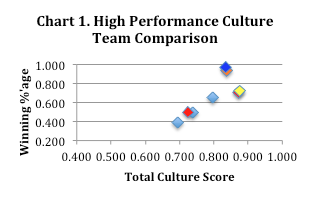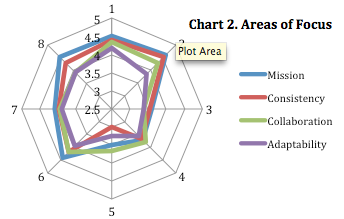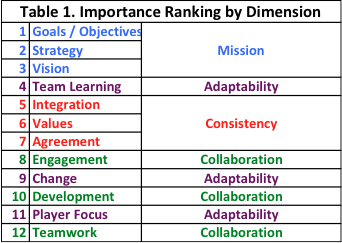Using a modified Denison Organizational Culture Survey to measure high performance sports teams, our results strongly indicate that team culture is a predictor of winning percentage.
For all the talk about how team culture impacts performance, there hasn’t been a way to measure what is meant by culture in the sports context. This study was designed to test the relationship and reach some general conclusions about what matters off the field in building high performance teams. The research comprised of seven NCAA Division I teams and one Ontario Universities Athletic Association program, with a wide range of winning percentages. Among the eight teams participating, three were collegiate National Champions, one finalist and four teams with mediocre to good performances in the 2013 - 2014 competitive season. A total number of 200 respondents completed the survey, with an average per team of 25.
Study
The survey included sixty cultural attribute statements categorized in twelve dimensions that characterize high performance cultures. The statements originally formed to assess organizational cultures by Denison Consulting were modified to suit a sports team environment. A typical attribute among the sixty statements is “There's buy-in from everyone about the right way and the wrong way to do things and conduct ourselves.” All current teammates, coaches, recent alumni and administrators close to the program scored the attributes anonymously on a five point Likert scale ranging from strongly disagree to strongly agree.
Using the Denison model as a guide, we grouped the sets of five statements with similar characteristics to reveal general strengths or weaknesses in areas that define sports team culture. The twelve dimensions that we analyzed include: player focus, teamwork, agreement, integration, development, team learning, values, change, strategy, goals & objectives, vision and engagement. These twelve were further grouped into four overall traits that reveal a general focus or tendency. The four general traits, described below, are Mission, Consistency, Adaptability and Collaboration.
 Results
Results
The overall results displayed in Chart 1 clearly show the relationship and indicate that a high performance culture produces higher winning percentage. The four teams who participated in national championship finals all scored above 84 percent on the culture survey and had an above .700 winning percentage. A causal relationship is clearly visible and points to the predictive validity of the model.
Higher culture score equals higher winning percentage.
The high scoring teams (See Chart 2 - Teams 1,2,6 and 8.) on the culture survey were consistent in two ways. First, they scored high on all four traits and second, they were consistent in the rank ordering of highest to lowest. The high performance programs focused first on Mission or command, second on Consistency, third on Collaboration or involvement and fourth on Adaptability. These traits are further defined below and indicate where the coaches place their emphasis.
Mission – Does the program provide for clarity, understanding, command and control over direction through focus on strategy, vision and specific goals and objectives.
 Consistency – Is there a consistent set of practices that define “how we do things around here” in terms of values, communication and integration of ideas and actions.
Consistency – Is there a consistent set of practices that define “how we do things around here” in terms of values, communication and integration of ideas and actions.
Collaboration – Are teammates and staff involved, committed and connected to others, and do they buy-in to the program.
Adaptability - Does the program learn, adjust and adapt to meet competitive challenges they face in the short and long term.
We looked closer at the actual dimensions that comprise the above traits and compared them independently with the team’s winning percentages. Table 1 below shows the results of importance ranking by dimension. We can see that six of the twelve dimensions that have the highest correlation to performance are part of the Mission and Consistency traits (colors correspond to traits). The exception is team learning.
 Sandwiched between two higher areas of focus, (Mission and Consistency) is emphasis on team learning – the importance of collective learning from experience and emphasis on creativity and innovation. The lower ranking of player focus and teamwork may appear to be surprising.
Sandwiched between two higher areas of focus, (Mission and Consistency) is emphasis on team learning – the importance of collective learning from experience and emphasis on creativity and innovation. The lower ranking of player focus and teamwork may appear to be surprising.
We followed up with all of the coaches to provide feedback and discuss the findings. Comments from the four coaches of the high scoring teams suggested that since teamwork is an outcome, it is not surprising that it ranks lower on the list.
Teamwork is a given desired competency in sports and it’s lower ranking may be explained by a coach’s focus mostly being committed to the input side, which is direction and communication - both highly valued elements of developing purpose and consistency. With respect to player focus, each coach admitted that more work needs to be done to address individual needs of players.
While more data points and a longer examination would amplify and further validate these results, it is sufficient from this project to generally conclude the following:
1. With some revision, all of the Denison dimensions translate well and can be validated for use in assessing sports teams. This is important because it gives us a way to measure high performance cultures, compare against a benchmark and highlight where opportunities for improvement exist for specific teams.
2. There is agreement on importance of order among equals. Some things carry more weight or require more attention than others. In this particular analysis we see that the best performing teams focus on Mission and Consistency slightly more than Collaboration and Adaptability.
3. Team learning is critical for success, more so than emphasis on individual players needs and teamwork itself.
Culture analysis feedback is particularly useful to coaches in terms of identifying the specific program attributes or characteristics they need to focus on for long-term success.
Having insight into how culture impacts performance in detail, being able to measure it, and taking specific actions to address the deficiencies ought to give coaches a distinct advantage to ensure long term success.




